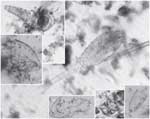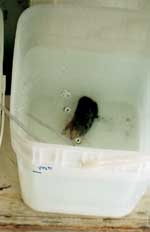PDF of this article (81 KB)

Karen Robinson John Zeldis Alex Ross
Experiments are helping to establish the feeding preferences of farmed mussels.


It has long been known that mussels are effective filterers of suspended material, including phytoplankton, bacteria, and non-nutritive material such as silt. Although early workers have reported the existence of a variety of animal remains in the stomachs and guts of bivalves, or in faecal material, bivalves are generally regarded as herbivores. Until recently, the potential effect of bivalve filtering on zooplankton populations has not been studied extensively.
Recent overseas studies have shown that under experimental and field conditions, blue mussels (Mytilus edulis) will inhale some zooplankton and either digest them or bind them up in mucus and discard them, thus killing and removing them from the population. Potentially, any large alteration of zooplankton populations could affect populations of larger predators that feed on them (such as fish) or affect other predator/grazer linkages that zooplankton provide in the ecosystem. Consequently, there has been concern about the effects of intensive mussel aqua-culture on this aspect of the surrounding ecosystems.
In New Zealand, the mussel Perna canaliculus is farmed extensively around the country, with the greatest concentration of farms in the Marlborough Sounds. Accordingly, a study to determine whether P. canaliculus would ingest zooplankton in significant amounts was carried out in the Marlborough Sounds in May 2002.
The study involved placing individual mussels in separate containers, adding a known concentration of zooplankton obtained from the local waters, then letting the mussels filter for a set amount of time. At the conclusion of the experiment, the mussels were dissected to determine the amount of zooplankton in the stomach. Water from each container was also taken at the beginning and the end of the experiment in order to measure phytoplankton and zooplankton depletion during mussel feeding. Faecal and other waste material was also collected to determine how much zooplankton was digested or rejected by the mussel.
Initial results from an examination of gut contents showed that the mussels had inhaled some zooplankton. Contents included copepods (either whole or in parts), tintinnids, mussel larvae, and phytoplankton, all in various stages of digestion. No fish eggs or larvae were seen in either the water or in the mussel gut contents or faeces; the likelihood of observing these even during fish spawning may be slim due to their fragile state and their low relative abundance. Further studies are planned to examine mussel feeding in other seasons. We will also investigate the gut contents of mussels taken directly from mussel farms.
This preliminary study on mussel feeding has given some support to the idea that mussels consume zooplankton. Our recent experiments, however, were carried out in an artificial situation, and may not reflect ingestion rates in natural populations, or in the mussel farms. They do certainly indicate that more extensive studies are warranted in order to determine the impact that P. canaliculus may have on zooplankton populations.
Karen Robinson, John Zeldis and Alex Ross are based at NIWA in Christchurch.
For further information contact: John Zeldis NIWA PO Box 8602 Christchurch Phone +64 3 348 8987 Fax +64 3 348 5548 j.zeldis@niwa.co.nz
Further reading
Davenport, J.; Smith R.J.J.W.; Packer, M (2000). Mussels Mytilus edulis: significant consumers and destroyers of mesozooplankton. Marine Ecology Progress Series 198:131–137
Lehane, C; Davenport, J. (2002). Ingestion of mesozooplankton by three species of bivalve: Mytilus edulis, Cerastoderma edule and Aequipecten opercularis. Journal of the Marine Biological Association U.K. 82:3999/1–6
